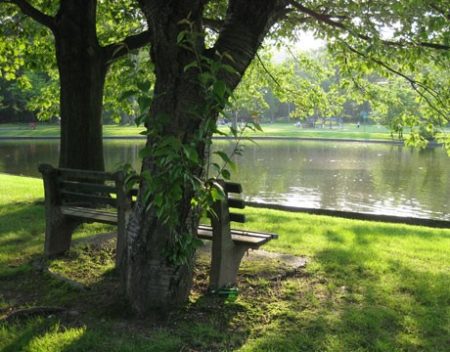August 9, 2019 – For the faint of heart who may find this topic difficult, I recommend you pass on this posting which was inspired by a conversation I had with another dog walker a couple of weeks ago, as we shepherded our dogs along a park path next to Mount Pleasant Cemetery here in Toronto. The cemetery is one of the oldest non-denominational burying grounds in Canada and was set up as both an arboretum and memorial to the dead. It contains more than 350 species of trees, 180,000+ graves, and markers, numerous walking paths, and is open to the public from sunrise to sundown daily. If any place seems compatible with a green and sustainable future it would be hard not to think of Mount Pleasant Cemetery. And yet it isn’t.
Conventional cemeteries and funeral homes in North American engage in burial practices that involve embalming, wooden caskets, digging into the ground 1.5 meters (5 to 6 feet), the use of concrete for gravestone mounts and grave liners, the manufactured gravestones themselves, and the upkeep of cemetery grounds.
The embalming fluids are toxic. The caskets may be made of exotic imported endangered trees from tropical countries. The depths of graves lead to decomposition that produces greenhouse gases (GHGs). The concrete manufacturing process for the mounts and liners produces GHGs as well. And then you have the gasoline-powered mowers that keep the cemetery grounds pristine while pumping out even more GHGs.
If you choose what you think is a better solution such as cremation, you may not tie up the land but in the burning of your body, you are producing GHGs.
So it would seem you can’t win in the death and burial game because traditional cultural rituals of remembrance aren’t focused on our carbon footprint.
Funeral Facts
In the United States funerals annually consume:
- 70.8 million liters (30 million board feet) of casket wood
- 90,000 tons of steel
- 1.6 million tons of concrete
- Over 3 million liters (around 800,000 gallons) of embalming fluid
A Greener Funeral Way
There is a growing movement to make death and internment greener because of climate change concerns. Borrowing from Jewish and Muslim cultures,
- where bodies are interned in the ground within a day after death, with rare exceptions, which means no embalming is required;
- where the only covering on the body is a biodegradable cloth shroud;
- where if a casket is required by local burial laws, it is made of biodegradable materials to ensure it quickly decomposes;
is inspiring funeral homes and cemeteries to consider alternatives to our existing North American and European traditions.
This has led to the formation of a Green Burial Council, headquartered in Placerville, California, where you can find, on its website, a directory of funeral homes and cemeteries for the states and provinces within the U.S. and Canada.
What burial standard do all members of the Council follow?
- No toxic embalming
- No burial vaults
- Biodegradable caskets, shrouds, and urns
- Burial depths of no more than a meter (3.3 feet) to promote greater oxygen flow, faster decomposition, and carbon sequestration
- No use of herbicides, pesticides, and chemical fertilizers in grounds maintenance
- The elimination of gravestones, substituting them with natural stone or other markers like a park bench
- The elimination of grave markers entirely using GPS maps to find burial sites
The Council has been set up to provide compliance specialists who can assist cemeteries and funeral homes to meet green burial standards.
Considering the dying and internment business earns those in the industry more than $20 billion annually in the U.S., and around $1.6 billion in Canada, this is a big market facing significant disruption if greener practices take hold.
What About Cremation and Other Alternatives?
Many who pride themselves on being environmentalists, and see land being tied up in cemeteries as wasteful, have opted for cremation. But each cremation emits almost 250 kilograms (540 pounds) of Co2, along with hydrochloric acid, sulfur dioxide, and carcinogenic-inducing dioxins. Cremation in North America is dramatically on the rise, seen by many to be a better environmental choice, but the way it is currently practiced isn’t. 250,000 tons of CO2 and other GHGs are emitted in the U.S. annually from cremations. That number is only going to grow.
One answer to cremation pollution is zero-emission technology, furnaces that produce no GHGs. Another approach is aquamation or water cremation. A third is recomposition, which is human composting, a process borrowed from farm animal decomposition practices. Zero-emission furnaces are new to the industry. And the latter two are not catching on even though these practices are more environmentally friendly. They just may strike a nerve with many, even those who see climate change as the existential issue of our time.
That’s why it is so difficult today for loved ones to mark the meaning of a life after we die in the age of climate change while being environmentally responsible. There are only hard choices when it comes to satisfying the needs of the environment and those of the grieving who wish to honour a life in death.
















